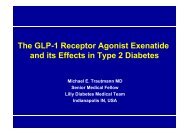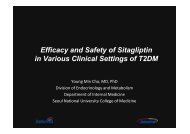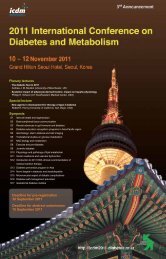Microsoft PowerPoint - S14-1_\300\374\274\272\277\317 [\310\243 ...
Microsoft PowerPoint - S14-1_\300\374\274\272\277\317 [\310\243 ...
Microsoft PowerPoint - S14-1_\300\374\274\272\277\317 [\310\243 ...
- No tags were found...
You also want an ePaper? Increase the reach of your titles
YUMPU automatically turns print PDFs into web optimized ePapers that Google loves.
Autoimmune Hypoglycemia2010. 05. 08SungWan, Chun
Introduction Hypoglycemia Plasma Glucose under 70 mg/dl Glucose levels
Introduction Hypoglycemia incidence In DCCT, 10-30% of type 1 diabetics per year and ofthose,10% require 3 rd party Intervention In the UKPDS,30-35%of type 2 diabetics on Insulin require3 rd party Intervention Classification of hypoglycemia Fasting hypoglycemia Postprandial(reactive) hypoglycemia
Introduction
IntroductionAutoimmune causes Insulin autoimmune syndrome (IAS) Insulin autoantibody (IAA) Type B insulin resistance Insulin receptor antibody (IR-A)
Insulin Autoimmune Syndrome
Insulin Autoimmune Syndrome First observation of IA and hypoglycemia A 34-year-old T1D woman with intermittent episodes ofsevere hypoglycemia The patient's serum contained IA with high insulin bindingcapacity and a slow rate of dissociation of insulin-antibodycomplexes It was postulated that insulin was "stored" at high levels inthe serum bound to IA, and that the slow rate of dissociationof insulin from the IA complex resulted in intermittenthypoglycemiaHARWOOD R. N Engl J Med. 1960
Insulin Autoimmune Syndrome In 1970, Hirata described a patientwith severe hypoglycemia with presence of IA Hirata suggested the term autoimmune insulin syndrome todescribe a syndrome of hypoglycemia elevated insulin levels high levels of IA without previous exposure to exogenousinsulinHirata Y, J Soc Diabetes Cos. 1970 Over 300 cases of IA-associated hypoglycemia have beenreported since 1970, with 80% of cases reported in Japan
Insulin Autoimmune Syndrome Clinical Presentation in 197 Asian postprandial hypoglycemia old-aged(>60), no sex predilection concomittent autoimmune disorder (thyroiditis) sulfhydryl group drug use (44%) : (methimazole, 50%) Clinical Presentation in 58 Non-Asian postprandial(42%), fasting(31%), both(24%) hypoglycemia middle-aged(>40), no sex predilection concomittent rheumatologic or hematologic disorder variable drugUchigata, Ann Med Interne. 1999Lupsa BC, Medicine. 2009
Insulin Autoimmune Syndrome Laboratory Findings in 197 Asian Insulin levels - usually > 100 mU/L (upto 100,000 mU/L) C-peptide - not suppressed Elevated IAA - polyclonal IgGs with variable kappa andlambda light chains and two classes of insulin-binding sites:high affinity/low capacity and low affinity/high capacity Laboratory Findings in 58 Non-Asian Insulin levels - usually > 100 mU/L (over upper limit) C-peptide - markedly elevated Elevated IAA - monoclonal IgGs (8/12 data collected)
Insulin Autoimmune Syndrome Pathogenesis of Hypoglycemia(1) "buffering" effect and release at inappropriate timing(2) cross-linking of insulin-insulin receptor complexes by IAresulting in the potentiation or prolongation of insulin action(3) development of anti-idiotypic antibodies to the IA that arecapable of directly activating insulin receptors(4) direct stimulation of insulin secretion by IA
Insulin Autoimmune Syndrome IV injection of 123 I-labeled insulin, the patient demonstratedpersistent labeled insulin activity in the blood and the absenceof liver or kidney uptake of labeled hormone Following treatment with prednisone and plasmapheresis, IAlevels decreased, and an increased clearance of 123 I-labeledinsulin from the blood pool Dozio, JCEM. 1998
Insulin Autoimmune Syndrome Origin of Insulin Antibodies in Patients with Hypoglycemia Origin of the IAA in this syndrome is unknown The development of IAA and hypoglycemia in patients with autoimmune disease history of exposure to sulfhydryl medications strongly associated with specific HLA class II alleles,DRB1*0406, DQA1*0301, and DQB1*0302 These alleles are 10 to 30 times more prevalent inJapanese and Koreans in comparison with Caucasians
Insulin Autoimmune Syndrome Origin of Insulin Antibodies in Patients with Hypoglycemia This distribution may explain the higher prevalence of thedisorder in the Japanese population
Insulin Autoimmune Syndrome Numerous drugs related to the development of IA- hydralazine, isoniazid, IFN-alpha sulfhydryl groups(methimazole, tiopronin, glutathionecaptopril, D-penicillamine) sulfhydryl groups interact with disulfide bonds in the insulinmolecule, making the insulin more immunogenic
Insulin Autoimmune Syndrome Diagnosis The presence of a high insulin level (>100 mU/L) and anincompletely suppressed C-peptide concentration duringhypoglycemia Insulinoma - insulin level usually < 100 muU/mL With exogenous insulin injection > 100 muU/mL,the C-peptide concentration is very low A history of autoimmune disease, exposure to a sulfhydrylcontainingmedication Presence of IAA (or IA)
Insulin Autoimmune Syndrome Altered insulin kinetics prolonged peak and delayed decline of insulin
Insulin Autoimmune Syndrome Course and Treatment In Uchigata's review of 197 cases from Japan, 82% ofpatients experienced spontaneous remissions within 3 to 6months of diagnosis Most cases of IA and hypoglycemia occur in the setting ofautoimmune disease with or without precipitating drugs For these patients, the hypoglycemia is usually transientand resolves spontaneously without permanent sequelae Possible offending medications should be stopped
Insulin Autoimmune Syndrome Course and Treatment In patients with severe or prolonged symptoms and inpatients with IA owing to monoclonal gammopathy spontaneous remission would not be expected various therapies have been tried frequent small meals (~6/day) low carbohydrate diet acarbose therapy steroid therapy (prednisolone 30 to 60 mg/day) plasmapheresis
Type B insulin resistance
Type B insulin resistance In 1975, Flier reported six women with an extreme insulinresistance and acanthosis nigricans In type A insulin resistance :a primary defect in the insulin receptor In type B insulin resistance :insulin receptor antibodies (IR-A)present in the circulation inhibitedinsulin binding to the insulin receptor
Type B insulin resistance Clinical Presentation Severe insulin resistance with acanthosis nigricans (95%) Either fasting or postprandial hypoglycemia Female predominance History of autoimmune disease, Hodgkin's disease Hypoglycemia at low-titer of IR-A
Type B insulin resistance Laboratory Findings Hypoglycemia may be severe(15~30 mg/dL) Insulin levels - inappropriately high C-peptide levels - appropriately low during hypoglycemia Low TG, high adiponectin, polyclonal IgG Elevated variable autoantibodies including antinuclear,antithyroid, antimitochondrial, and antiplatelet antibodies -suggestive of subclinical autoimmune disease The absence of any of these laboratory findings in a patientwith IR-A and hypoglycemia should prompt a search forHodgkin's disease
Type B insulin resistance Pathogenesis of Hypoglycemia IR-A for hyperglycemia insulin antagonist in high titer accelerated receptor degradation receptor downregulation IR-A for hypoglycemia insulin agonist in low titer
IR-AType B insulin resistance Polyclonal IgGs, which may becomposed of varioussubpopulation of immunoglobulinswith varying agonist or antagonistactivity toward the insulin receptor In support of this hypothesis, Sestiand co-workers demonstrated thattwo IgG subfractions from apatient with IR-A andhypoglycemia differed in theirability to inhibit insulin binding tothe two distinct human insulinreceptor subtypesSesti G, Diabetes. 1992
Type B insulin resistance "Spare receptor hypothesis" When IR-A titers are relatively low, insulin agonist effectsmay be near maximal with little effect on insulin receptordegradation rate or receptor number, as only a smallfraction of insulin receptors are occupied When IR-A titers are high, binding of IR-A to receptors isnear maximal, resulting in receptor downregulation,decreased receptor number, insulin resistance, andhyperglycemia
Type B insulin resistance Diagnosis The diagnosis of hypoglycemia owing to IR-A requires thedemonstration of IR-A in the serum The immunoprecipitation assay is considered the moresensitive test for detecting IR-A because it will detect IR-Athat bind to the receptor at sites other than the insulinbindingsite IA are usually negative, although low titers may be presentin subjects treated with insulin during a precedinghyperglycemic phase
Type B insulin resistance Course and Treatment Hypoglycemia in association with IR-A a high mortality rate owing to progressive autoimmunedisease, malignancy, or hypoglycemia Because of this risk and the severity of the hypoglycemia,aggressive therapy is often warranted High-dose steroid therapy (prednisone, 1 mg/kg/d to 120mg/d) seems to be the most effective therapy Hypoglycemia may respond rapidly to steroid therapy wellbefore any change in IR-A titers is noted
Type B insulin resistance Course and Treatment Some patients remain in remission, whereas others mayrequire chronic therapy Plasmapheresis and immunosuppressive therapy withcyclophosphamide have been employed to reduce IR-Atiters but with less consistent results Plasmapharesis can dramatically lower IR-A titers; however,the effect is transient, and the impact on clinical parametersmay not match the decline in antibody level
Summary 4 Caucassian IAS profileIASType B IR
Summary
Conclusion Autoimmune forms of hypoglycemia are uncommon However, they should be considered in any patient withhypoglycemia in the setting of unsuppressed insulin levels Although not essential for the diagnosis, the coexistence of aseparate autoimmune or hematologic disease should besought in patients with a diagnosis of autoimmunehypoglycemia
감 사 합 니 다A
Insulin immunogenecity Insulin autoantibodies(IA) 1% to 8% of healthy subjects without diabetes or autoimmune disease 40% of newly diagnosed type 1 diabetic patients 30% of nondiabetic patients with other autoimmune disease 10% of patients receiving alpha-interferon for chronic viral hepatitisDi Cerbo A, J Endocrinol Invest. 1995Di Mario U, Acta Endocrinol. 1990Palmer J, Diabetes Metab Rev. 1987Wilkin TJ, Endocr Rev. 1990
Insulin Autoimmune Syndrome Laboratory Findings IA & IAA - undistinguishable in insulin-treated diabetic patients IAA usually bind equally well to human, beef, and pork insulins,although cases of IA with binding specificity restricted to humaninsulin have been reported
InsulinomaPancreatic β-cell tumors that secrete InsulinSmall,solitary, benign( < 10% malignant)Inability of insulinoma cells to suppress insulin secretion during low levels ofcirculating glucose, leading to severe hypoglycemiaDiagnosis and Tumor Localization Very high Insulin levels spiral CT, arteriography, ultrasonographyTreatment of Choice Enucleation Recurrence at 10 yrs is 6% and 20 yrs is 10%
Interpretation of values after 72 hour test
Target autoantigens in type 1 diabetes mellitusGlutamic acid decarboxylase (GAD)Insulin autoantibody (IAA)Insulinoma –associated protein 2 (IA-2)Carboxypeptidase H, PM-1 polar antigenIslet cell proteins of varying size and unknown function - 37 or 40 kD, 38 kD, 52 kD, 69 kDPeripherinHeat shock protein 65Insulin receptorEndocrine cell antigensCytoskeletal proteins - tubulin, actin, reticulinNuclear antigens - single-stranded DNA and RNAAutoantibody :GADA (antibody to glutamic acid decarboxylase)--- β-cell destruction early markerICA (islet cell autoantibody)—specificity lowIAA (autoantibody to insulin) —specificity lowIA-2 ( autoantibody to tyrosine phosphatases IA-2 andIA-2β)---specificity high
Target autoantigens in type 1 diabetes mellitus Insulin auto antibody (IAA) The early appearance of anti-insulin antibodies suggests that insulinis an important autoantigen Confirmed at 1993, from studies in NOD mice Glutamic acid decarboxylase (GAD) found in about 70 percent of patients with type 1 diabetes at the timeof diagnosis Insulinoma-associated protein 2 (IA-2) neuroendocrine protein called insulinoma-associated protein 2, whichis a protein tyrosine phosphatase 58 percent of patients with type 1 diabetes at the time of diagnosis usually appear later than IAA and GAD, and are highly associatedwith expression of multiple anti-islet autoantibodies and progressionto diabetes
Type 1 DM PathogenesisHLA-DR/DQGenetic susceptibilityEnviromental factors initiate(Virus infection, chemical, diet)GADA,IAA,ICAIA2 andIA-2βautoimmuneidiopathyβ-cell destructionAbsolute insulin deficiency(ID)(Low C-peptide level)Prone to ketoacidosis
Introduction IA have also been demonstrated with lispro insulin therapy andin women receiving short-term human insulin therapy forgestational diabetes IA induced in response to insulin therapy are typicallypolyclonal IgGs with two classes of binding sites sites with high affinity/low capacity (Ka 10 7 M -1 , b10 -9 M) sites with low affinity/high capacity (Ka 10 7 M -1 , b10 -7 M)



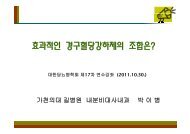
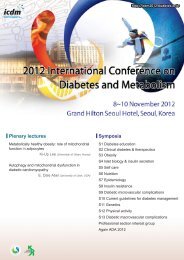
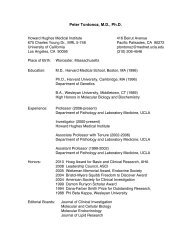
![Microsoft PowerPoint - src.ppt [\310\243\310\257 \270\360\265\345]](https://img.yumpu.com/47977670/1/190x134/microsoft-powerpoint-srcppt-310243310257-270360265345.jpg?quality=85)



![Microsoft PowerPoint - src.ppt [\310\243\310\257 \270\360\265\345]](https://img.yumpu.com/44373305/1/190x134/microsoft-powerpoint-srcppt-310243310257-270360265345.jpg?quality=85)
